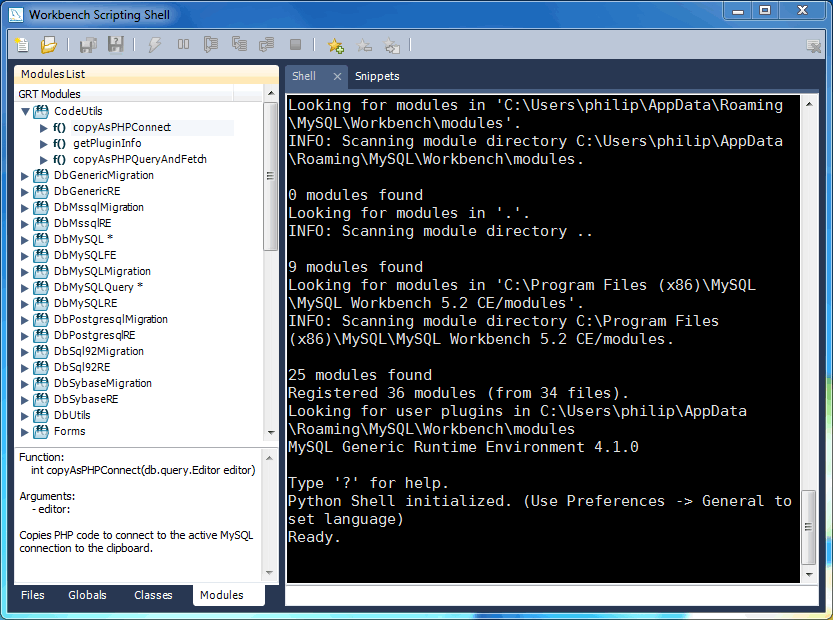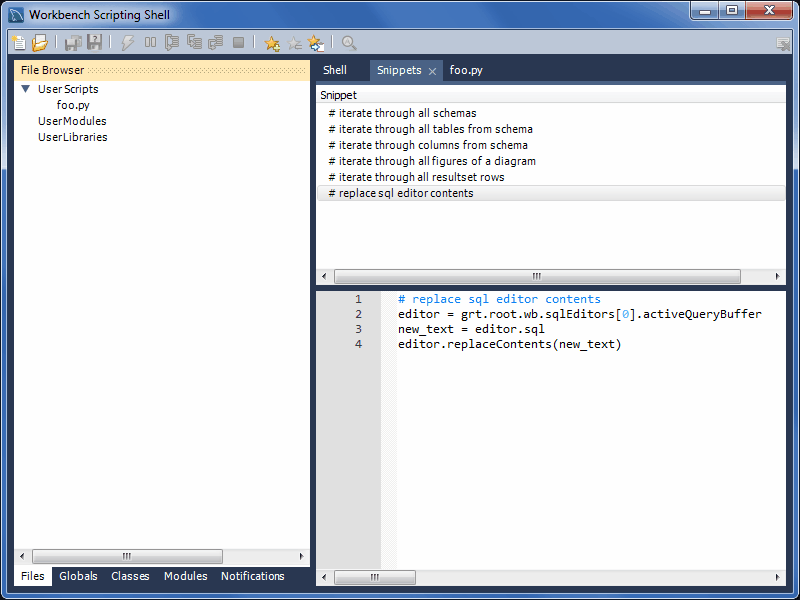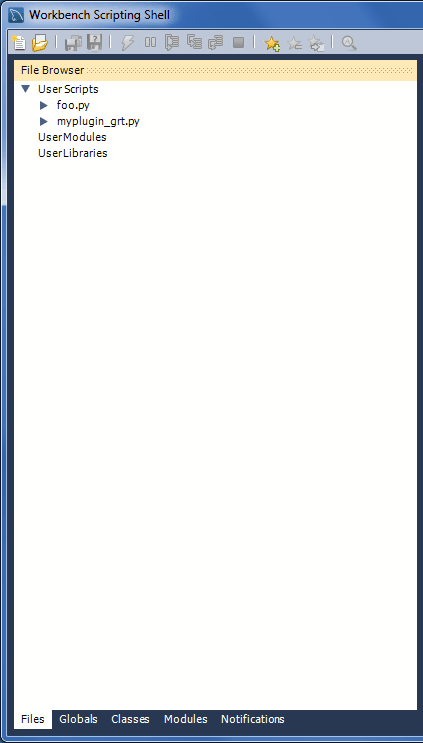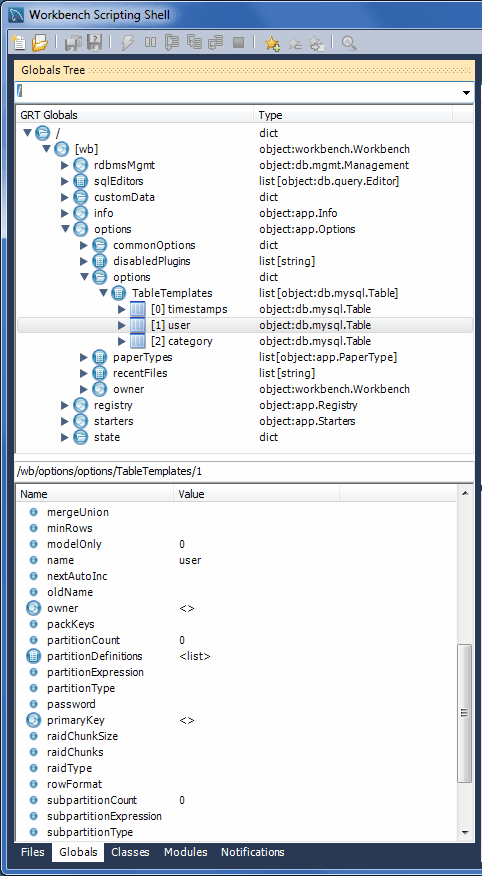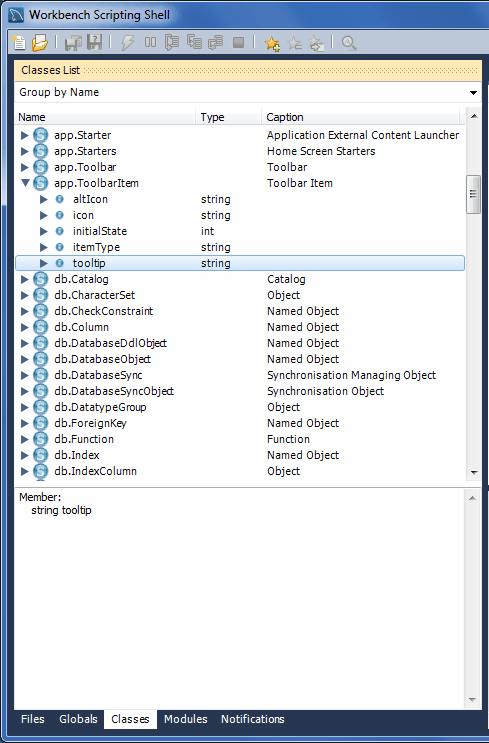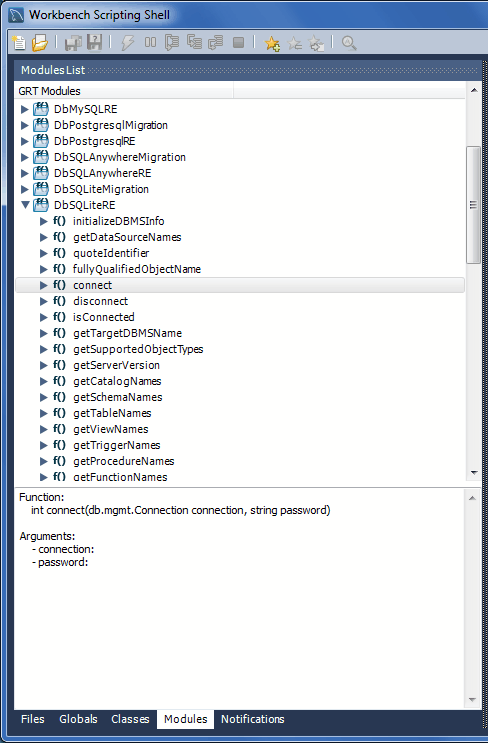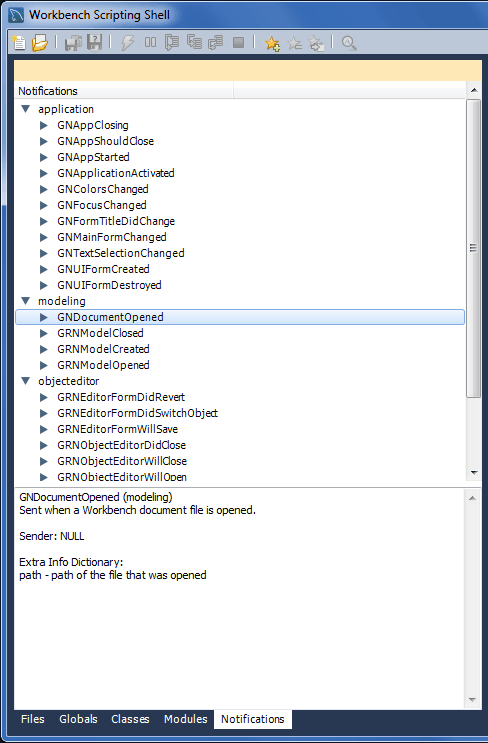Table of Contents
MySQL Workbench provides an extension and scripting system that enables the developer to extend MySQL Workbench capabilities. While the core of MySQL Workbench is developed using C++, it is possible to harness this core functionality using the Python scripting language. MySQL Workbench also provides access to a cross-platform GUI library, MForms, which enables the creation of extensions that feature a graphical user interface.
The extension system enables the following capabilities:
Automate common tasks
Extend the Workbench user-interface
Create Tools/Plugins (code which can be invoked from the Workbench menu system)
Manipulate schemata
Create custom Workbench features
The GRT, or Generic RunTime, is the internal system used by Workbench to hold model document data. It is also the mechanism by which Workbench can interact with Modules and Plugins. Workbench model data, such as diagrams, schemata, and tables, is stored in a hierarchy of objects that can be accessed by any plugin. The information is represented using standard data types: integers, doubles, strings, dicts, lists, and objects.
The GRT can be accessed using the Python scripting language. Awareness is required of how the GRT data types map into Python. For example, the GRT integer, double, and string data types are seen as corresponding Python data types. Lists and dicts are kept in their internal representation, but can generally be treated as Python lists and dicts, and accessed in the usual way. Objects contain data fields and methods, but the GRT recognizes only objects from a pre-registered class hierarchy.
It is possible to fully examine the classes contained within the
GRT using the Workbench Scripting Shell. Dots in class names are changed to
underscores in their Python counterparts. For example,
db.mysql.Table becomes
db_mysql_Table in Python.
The Application Objects Tree (GRT Tree)
As mentioned previously, Workbench document data is stored in an object hierarchy. This hierarchy is known as the GRT Tree. The GRT Tree can be accessed and modified using Python or C++. Be careful when modifying the GRT Tree as mistakes can lead to document corruption. Backups should be made before manipulating the tree. Read-only access to the tree is the safest approach, and is sufficient in most cases.
The main nodes in the Application Object Tree
Table C.1 The main nodes in the Application Object Tree
| Node | Description |
|---|---|
| wb.registry | Application data such as plugin registry, list of editors, and options. |
| wb.customData | A generic dictionary for data you can use to store your own data. This dictionary is saved and reloaded with Workbench and is global (not document specific). |
| wb.options | Contains some default options that are used by Workbench. |
| wb.rdbmsMgmt | Internal registry of supported RDBMS modules, known data types. |
| wb.doc | The currently loaded model document. |
| wb.doc.physicalModels[0] | The currently loaded model object, containing the database catalog and diagrams. |
| wb.doc.physicalModels[0].catalog | The database catalog for the model. Contains the list of schemata. |
| wb.doc.physicalModels[0]catalog.schemata | List of schemata in the model. Individual schema can be accessed as a list: schemata[0], schemata[1] ... |
| wb.doc.physicalModels[0].catalog.schemata[0].tables (.views, .routines, ...) | Lists of tables, views, routines in the schema. |
| wb.doc.physicalModels[0].diagrams | List of EER diagrams in the model. |
| wb.doc.physicalModels[0].diagrams[0].figures (.layers, .connections, ...) | List of figures, layers, connections (relationships) in the diagram. |
In the GRT Modules are libraries containing a list of functions that are exported for use by code in other modules, scripts, or Workbench itself. Modules can be written in C++ or Python, but the data types used for arguments and the return value must be GRT types.
GRT modules are similar to Python modules, but are imported from
the built-in grt module, instead of directly
from an external file. The list of modules loaded into the
grt module is obtained from
grt.modules. Modules can be imported in Python
using statements such as from grt.modules import
WbModel.
To export functions as a module from Python code, you must carry out the following steps:
The source file must be located in the user modules folder. This path is displayed in the Workbench Scripting Shell with the label Looking for user plugins in.... It is also possible to install the file using the main menu item , .
The source file name must have the extension
_grt.py; for example,my_module_grt.py.Some module metadata must be defined. This can be done using the
DefineModulefunction from the wb module:from wb import * ModuleInfo = DefineModule(name='MyModule', author='Your Name', version='1.0')
Functions to be exported require their signature to be declared. This is achieved using the export decorator in the previously created ModuleInfo object:
@ModuleInfo.export(grt.INT, grt.STRING) def checkString(s): ...
For the
exportstatement, the return type is listed first, followed by the input parameter types, specified as GRT typenames. The following typenames can be used:grt.INT: An integer value. Also used for boolean values.grt.DOUBLE: A floating-point numeric value.grt.STRING: UTF-8 or ASCII string data.grt.DICT: A key/value dictionary item. Keys must be strings.grt.LIST: A list of other values. It is possible to specify the type of the contents as a tuple in the form(grt.LIST, <type-or-class>). For example, (grt.LIST, grt.STRING) for a list of strings. For a list of table objects, the following would be specified:(grt.LIST, grt.classes.db_table).grt.OBJECT: An instance of a GRT object or a GRT class object, fromgrt.classes.
NoteThese types are defined in the
grtmodule, which must be imported before they are available for use.
The following code snippet illustrates declaring a module that exports a single function:
from wb import *
import grt
ModuleInfo = DefineModule(name='MyModule', author="your name", version='1.0')
@ModuleInfo.export(grt.DOUBLE, grt.STRING, (grt.LIST, grt.DOUBLE))
def printListSum(message, doubleList):
sum = 0
for d in doubleList:
sum = sum + d
print message, sum
return sum
Plugins are special Modules that are exposed to the user through the Workbench GUI. This is typically done using the main menu, or the context-sensitive menu. Much of the MySQL Workbench functionality is implemented using plugins; for example, table, view, and routine editors are native C++ plugins, as are the forward and reverse engineering wizards. The Administrator facility in MySQL Workbench is implemented entirely as a plugin in Python.
A plugin can be a simple function that performs some action on an
input, and ends without further interaction with the user.
Examples of this include auto-arranging a diagram, or making batch
changes to objects. To create a simple plugin, the function must
be located in a module and declared as a plugin using the
plugin decorator of the
ModuleInfo object.
Plugins can have an indefinite runtime, such as when they are driven by the user through a graphical user interface. This is the case for the object editors and wizards within MySQL Workbench. Although the wizard type of plugin must be declared in the usual way, only the entry point of the plugin will need to be executed in the plugin function, as most of the additional functionality will be invoked as a result of the user interacting with the GUI.
Reloading a plugin requires MySQL Workbench to be restarted.
Imported plugin files (and their compiled counterparts) are stored here:
Table C.2 User Plugin File Location
| Operating System | File Path |
|---|---|
| Windows | %AppData%\MySQL\Workbench\modules |
| OS X | ~username/Library/Application Support/MySQL/Workbench/modules |
| Linux | ~username/.mysql/workbench/modules |
Declare a plugin using this syntax:
@ModuleInfo.plugin(plugin_name, caption, [input], [groups], [pluginMenu])
These parameters are defined as follows:
plugin_name: A unique name for the plugin. It may contain only alphanumeric characters, dots, and underscores.
caption: A caption to use for the plugin in menus.
input: An optional list of input arguments.
groups: Optional list of groups the plugin belongs to. Recognized values are:
Overview/Utility: The menu in the Model Overview.Model/Utility: The menu for diagram objects.Menu/<category>: The menu in the main menu.
pluginMenu: Optional name of a submenu in the Plugins menu where the plugin should appear. For example, , , . This is equivalent to adding a
Menu/<category>in the groups list.
MySQL Workbench is implemented with a C++ core back-end, and a native
front-end for each supported platform. Currently the front-end is
implemented with Windows Forms on Microsoft Windows, GTK+ on
Linux, and Cocoa on OS X. This approach permits the application to
have a native look and feel, while reducing the amount of work
required to maintain the project. However, the GUI functionality
required by MySQL Workbench can be met by a subset of graphical
operations. These are implemented in a cross-platform GUI library,
MForms. This further reduces the development effort because plugin
developers can use MForms rather than writing front-end specific
code for each supported platform. This also helps consistency of
operation across all platforms. MForms is coded in C++, but
provides a Python interface. To use it, the Python code must
import the mforms module.
MForms Containers
Given the problems of using an absolute coordinate system across different platforms, MForms employs containers that perform automatic layout. The basic containers that MForms provides include:
Form: A top-level window which can contain a single control, usually another container. The window will be sized automatically to fit its contents, but can also be sized statically.
Box: This container can be filled with one or more controls in a vertical or horizontal layout. Each child control can be set to use either the minimum of required space, or fill the box in the direction of the layout. In the direction perpendicular to the layout, for example vertical in a horizontal layout, the smallest possible size that can accommodate all child controls will be employed. So, in this example, the smallest height possible to accommodate the controls would be used.
Table: This container can organize one or more controls in a grid. The number of rows and columns in the table, and the location of controls within the grid, can be set by the developer.
ScrollView: This container can contain a single child control, and adds scrollbars if the contents do not fit the available space.
The Workbench Scripting Shell provides a means for entering and executing Python scripts. Through the use of the scripting shell, MySQL Workbench can support new behavior and data sources using code written in Python. The shell can also be used to explore the current Workbench GRT (Generic RunTime) facilities.
The scripting shell is not only useful for expanding MySQL Workbench. You can use a script file from the scripting shell command line to perform repetitive tasks programmatically.
Although they serve a different purpose, the MySQL Utilities are also integrated with MySQL Workbench. For more information, see Appendix F, MySQL Utilities.
To open the Workbench Scripting Shell, select , from the main menu. You can also open the Workbench Scripting Shell using the Control + F3 key combination on Windows and Linux, Command + F3 on OS X, or by clicking the shell button above the EER diagram navigator. The Workbench Scripting Shell will then open in a new dialog.
The following screenshot shows the Workbench Scripting Shell dialog.
The Workbench Scripting Shell is primarily used for running Python scripts, or
directly typing commands in Python. However, you can also use it
to access the Workbench Scripting Shell Scripting Library functions and global
functions and objects. To see the available commands, type
“?”. You can also cut and paste
text to and from the shell window.
The Snippets tab is a scratch pad for saving code snippets. This makes it easy to reuse and execute code in MySQL Workbench.
Opened script file tabs are to the right of the
Snippets tab. Script tabs are labeled with
the script's filename, or Unnamed for
snippets without a name. You can cut-and-paste to and from the
tabs, or right-click on a snippet to open a context menu with
options to , , or .
While individual commands can be entered into the shell, it is also possible to run a longer script, stored in an external file, using the main menu item , . When scripts are run outside of the shell, to see the output use the main menu item , .
It is also possible to run script files directly from the shell. For details on running script files, type ? run at the Workbench Scripting Shell prompt. The following message is displayed:
Help Topics ----------- grt General information about the Workbench runtime scripting Practical information when working on scripts and modules for Workbench wbdata Summary about Workbench model data organization modules Information about Workbench module usage plugins Information about writing Plugins and Modules for Workbench Type '? [topic]' to get help on the topic. Custom Python Modules --------------------- grt Module to work with Workbench runtime (grt) objects grt.root The root object in the internal Workbench object hierarchy grt.modules Location where Workbench modules are available grt.classes List of classes known to the GRT system mforms A Module to access the cross-platform UI toolkit used in some Workbench features wb Utility module for creating Workbench plugins Type 'help(module/object/function)' to get information about a module, object or function. Type 'dir(object)' to get a quick list of methods an object has. For an introductory tutorial on the Python language, visit http://docs.python.org/tutorial/ For general Python and library reference documentation, visit http://python.org/doc/
Within the Workbench Scripting Shell, there are five tabs on the top of the left side panel: Files, Globals, Classes, and Modules, and Notifications.
An exception is thrown while attempting to use
input() or read from
stdin.
The Workbench Scripting Shell features the Files, Globals, Classes, Modules, and Notifications tabs, in addition to the main Shell tab.
The Files Tab
Lists folders and files for user-defined (custom) script files. The categories are User Scripts, User Modules, and User Libraries.
By default, scripts are stored in the
scripts/ folder of your MySQL Workbench
configuration folder. These default locations are:
Table C.3 Default Scripts Location
| Operating System | Default scripts/ path |
|---|---|
| Linux | ~/.mysql/workbench/scripts |
| OS X | ~/Library/Application\
Support/MySQL/Workbench/scripts/ |
| Windows 7 | C:\Users\[user]\AppData\Roaming\MySQL\Workbench\scripts\ |
The Globals Tab
At the top of the window is a list that is used to select the starting point, or root, of the GRT Globals tree displayed beneath it. By default, this starting point is the root of the tree, that is, '/'. You can expand or collapse the GRT Globals tree as desired. The GRT Globals tree is the structure in which MySQL Workbench stores document data. Clicking any item results in its name and value being displayed in the panel below the tree.
The Classes Tab
A class is a user-defined data type formed by
combining primitive data types: integers, doubles, strings,
dicts, lists, and objects. This tab shows the definitions of the
classes used by the objects in the Modules
tab. Clicking a class causes a brief description of the class to
be displayed in a panel below the classes explorer.
When the Classes tab is selected, the list displays the following items:
Group by Name: Group by the object name
Group by Hierarchy: Group by inheritance
Group by Package: Group by functionality
The default view for this tab is Group By Name. This view shows all the different objects arranged alphabetically. Click the icon or double-click a package to show the properties of the struct.
If you switch to the hierarchical view, you will see
GrtObject: the parent object from which all
other objects are derived.
The Modules Tab
The Modules tab enables you to browse the MySQL Workbench installed modules and their functions. Clicking a module within the explorer causes its details to be displayed in a panel below the explorer. This facility is useful for exploring the available modules, and their supported functions. It is also a way to check whether custom modules have been correctly installed.
The Notifications Tab
The set of notification classes used by
MySQL Workbench modules. Click a notification class for a
description of its use.
This tutorial shows you how to extend MySQL Workbench by creating a plugin.
The Sample Plugin
EER Diagrams are useful for visualizing complex database schemata.
They are often created for existing databases, to clarify their
purpose or document them. MySQL Workbench provides facilities for
reverse engineering existing databases, and then creating an EER
Diagram automatically. In this case, relationship lines between
foreign keys in the table will automatically be drawn. This
graphical representation makes the relationships between the tables
much easier to understand. However, one of the most popular storage
engines for MySQL, MyISAM, does not include support for foreign
keys. This means that MyISAM tables that are reverse engineered will
not automatically have the relationship lines drawn between tables,
making the database harder to understand. The plugin created in this
tutorial gets around this problem by using the fact that a naming
convention is often used for foreign keys:
tablename_primarykeyname. Using this convention,
foreign keys can automatically be created after a database is
reverse engineered, which will result in relationship lines being
drawn in the EER diagram.
Algorithm
The basic algorithm for this task would be as follows:
for each table in the schema
for each column in the table
look for another table whose name and primary key name match the current column name
if such a table is found, add a foreign key referencing it
As iterating the complete table list to find a match can be slow for models with a large number of tables, it is necessary to optimize by pre-computing all possible foreign key names in a given schema.
import grt
def auto_create_fks(schema):
fk_name_format = "%(table)s_%(pk)s"
possible_fks = {}
# create the list of possible foreign keys from the list of tables
for table in schema.tables:
if table.primaryKey:
format_args = {'table':table.name, 'pk':table.primaryKey.name}
fkname = fk_name_format % format_args
possible_fks[fkname] = table
# go through all tables in schema, this time to find columns that may be a fk
for table in schema.tables:
for column in table.columns:
if possible_fks.has_key(column.name):
ref_table = possible_fks[column.name]
if ref_table.primaryKey.formattedType != column.type:
continue
fk = table.createForeignKey(column.name+"_fk")
fk.referencedTable = ref_table
fk.columns.append(column)
fk.referencedColumn.append(ref_table.primaryKey)
print "Created foreign key %s from %s.%s to %s.%s" \
% (fk.name, table.name, column.name, ref_table.name, ref_table.primaryKey.name)
auto_create_fks(grt.root.wb.doc.physicalModels[0].catalog.schemata[0])
Creating a Plugin from a Script
To create a plugin from an arbitrary script, it is first necessary to make the file a module, and export the required function from it. It is then necessary to declare the module as a plugin, and specify the return type and input arguments.
from wb import *
import grt
ModuleInfo = DefineModule(name="AutoFK", author="John Doe", version="1.0")
@ModuleInfo.plugin("sample.createGuessedForeignKeys",
caption="Create Foreign Keys from ColumnNames",
input=[wbinputs.objectOfClass("db.mysql.schema")],
groups=["Overview/Utility"])
@ModuleInfo.export(grt.INT, grt.classes.db_mysql_Schema)
def auto_create_fks(schema):
...
With the addition of the preceding code, the
auto_create_fks() function is exported and will
be added to the schema context menu in the model overview. When
invoked, it receives the currently selected schema as its input.
